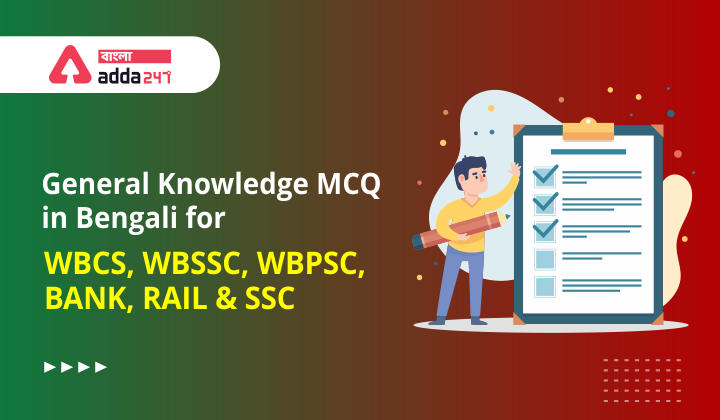General Knowledge MCQ questions and answers for Tripura PSC: Welcome to Adda 247. ADDA 247 Bengali is giving you General Knowledge MCQ in Bengali for SSC MTS Exam. Here you get ten Multiple Choice Questions and Answers with Solutions every day. Here you will find all the essential questions and answers that will help you increase your knowledge and move you toward fulfilling your goals. Study these General Knowledge MCQs regularly and succeed in the exams.
| General Knowledge MCQ in Bengali | |
| Topic | General Knowledge MCQ |
| Category | Daily Quiz |
| Used for | SSC MTS |

General Knowledge MCQ | জেনারেল নলেজ MCQ
Q1. ভারতীয় অর্থনীতি নিম্নলিখিত আর্থিক বছরে জিডিপিতে সর্বোচ্চ বৃদ্ধির হার দেখেছে:
(a) 2003 – 04
(b) 2004 – 05
(c) 2005 – 06
(d) 2006 – 07
Q2. নিচের কোন অর্থনীতিবিদ ভারতে অর্থনৈতিক উন্নয়নের এলপিজি মডেলের প্রস্তাব করেছিলেন?
(a) ওয়াই.বি. রেড্ডি
(b) কে.ভি. কামাঠ
(c) মনমোহন সিং
(d) এর কোনটিই নয়
Q3. অর্থনৈতিক পরিকল্পনা এর মধ্যে কোনটিতে রয়েছে
(a) ইউনিয়ন তালিকা
(b) রাজ্যের তালিকা
(c) সমবর্তী তালিকা
(d) কোনো নির্দিষ্ট তালিকা নয়
Q4. স্বাধীনতা-পরবর্তী সময়ে, ভারতে প্রথম অর্থনৈতিক সংস্কারের সূচনা কার আমলে হয়েছিল:
(a) জনতা পার্টি সরকার (1977)
(b) ইন্দিরা গান্ধী সরকার (1980)
(c) রাজীব গান্ধী সরকার (1985)
(d) পি.ভি. নরসিংহ রাও সরকার (1990)
Q5. নিম্নলিখিত বিবৃতি বিবেচনা করুন:
(1) ভারতীয় অর্থনীতির এলপিজি মডেল অষ্টম পঞ্চবার্ষিক পরিকল্পনায় সম্পূর্ণরূপে বাস্তবায়িত হয়েছিল।
(2) অষ্টম পরিকল্পনায় বার্ষিক গড় বৃদ্ধির হার 5.6% কল্পনা করা হয়েছিল কিন্তু প্রকৃত বৃদ্ধির হার ছিল 6.8%।
উপরে প্রদত্ত বিবৃতিগুলির মধ্যে কোনটি সঠিক/সঠিক?
(a) শুধুমাত্র 1
(b) শুধুমাত্র 2
(c) 1 এবং 2 উভয়ই
(d) 1 বা 2 নয়
Q6. নিচের কোনটি ভারতের অর্থনৈতিক পরিকল্পনার বৈশিষ্ট্য নয়?
(a) সীমিত কেন্দ্রীকরণ
(b) গণতান্ত্রিক সমাধান
(c) অপরিহার্য প্রকৃতির পরিকল্পনা
(d) নির্দেশক প্রকৃতির পরিকল্পনা
Q7. নিচের কোনটি সত্য?
(a) আর্থিক পরিকল্পনা ভৌত পরিকল্পনার চেয়ে বেশি গুরুত্বপূর্ণ।
(b) আর্থিক পরিকল্পনার চেয়ে ভৌত পরিকল্পনা বেশি গুরুত্বপূর্ণ।
(c) ভৌত এবং আর্থিক পরিকল্পনা সমানভাবে গুরুত্বপূর্ণ।
(d) ভৌত এবং আর্থিক পরিকল্পনা পরিপূরক।
Q8. 20 দফা অর্থনৈতিক কর্মসূচী সর্বপ্রথম কোন সালে ঘোষণা করা হয়?
(a) 1975
(b) 2006
(c) 1986
(d) 1982
Q9. সংবিধানে নিহিত নিম্নলিখিতগুলির মধ্যে কোনটি থেকে ভারতের পরিকল্পনা তার উদ্দেশ্য এবং সামাজিক প্রাঙ্গনে উদ্ভূত হয়?
(a) মৌলিক অধিকার
(b) মৌলিক দায়িত্ব
(c) রাষ্ট্রীয় নীতির নির্দেশমূলক নীতি
(d) উপরের কোনটি নয়
Q10. ভারতে অর্থনৈতিক পরিকল্পনার ধারণাটি কোন দেশ থেকে নেওয়া হয়েছে?
(a) মার্কিন যুক্তরাষ্ট্র
(b) যুক্তরাজ্য
(c) রাশিয়া
(d) ফ্রান্স
General Knowledge MCQ solutions | জেনারেল নলেজ MCQ সমাধান
S1.Ans. (d)
Sol. In the year 2006 – 07, the Indian economy has witnessed highest growth rate in GDP. The economy grew by around 10%.
S2.Ans. (c)
Sol. The economy of India had undergone significant policy shifts in the beginning of the 1990s. This new model of economic reforms is commonly known as the LPG or Liberalization, Privatization and Globalization model. LPG model of economic development in India was proposed by Dr. Manmohan Singh, economist and finance minister at that time.
S3.Ans. (c)
Sol. The Concurrent List or List-III is a list of 52 items given in Part XI of the Constitution of India, concerned with relations between the Union and States. Economic planning is specified in Concurrent list.
S4.Ans. (d)
Sol. The economy of India had undergone significant policy shifts in the beginning of the 1990s. This new model of economic reforms is commonly known as the LPG or Liberalization, Privatization and Globalization model. LPG model of economic development in India was proposed by Dr. Manmohan Singh, economist and finance minister at that time under the PV Narashimha Rao Government in 1990.
S5.Ans. (c)
Sol. The economy of India had undergone significant policy shifts in the beginning of the 1990s at the time of eighth plan. This new model of economic reforms is commonly known as the LPG or Liberalization, Privatization and Globalization model. LPG model of economic development in India was proposed by Dr Manmohan Singh, economist and finance minister at that time. Moreover the Eighth plan envisaged an annual average growth rate of 5.6% but real growth rate was 6.8%.
S6.Ans. (c)
Sol. Indicative planning is peculiar to the mixed economy. In a mixed economy, the public and private sectors work together. In indicative planning the private sector is neither rigidly controlled nor directed to fulfill the targets and priorities of the plan. The state provides all types of facilities to the private sector but does not direct it, rather indicates the areas in which it can help in implementing the plan. Under imperative planning all economic activities and resources of the economy operate under the direction of the state. There is complete control over the factors of production by the state. There is no consumer’s sovereignty in such planning.
S7.Ans. (d)
Sol. Physical planning refers to the allocation of resources in terms of men, materials and machinery. In physical planning, an overall assessment is made of the available real resources such as raw materials, manpower, etc., and how they have to be obtained so that bottlenecks may be eliminated during the plan. Physical planning requires the fixation of physical targets with regard to agricultural and industrial production, socio-cultural and transportation services, consumption levels and in respect of employment, income and investment levels of the economy. Physical planning has to be viewed as an overall long-term planning rather than a short-term piecemeal planning.
S8.Ans. (a)
Sol. The Twenty Point Programme was initially launched by Prime Minister Indira Gandhi in 1975 and was subsequently restructured in 1982 and again on 1986. With the introduction of new policies and programmes it has been finally restructured in 2006 and it has been in operation at present. The basic objective of the 20-Point Programme is to eradicate poverty and to improve the quality of life of the poor and the under privileged population of the country.
S9.Ans. (c)
Sol. The planning of India derives its objectives and social premises followed by the directive principles of state policy. The Directive Principles of state policy are guidelines to the central and state governments, to be kept in mind while framing laws and policies. These provisions, contained in Part IV of the Constitution of India, are not enforceable by any court, but the principles laid down therein are considered fundamental in the governance of the country.
S10.Ans. (c)
Sol. The concept of Economic planning in India is derived from Russia.




